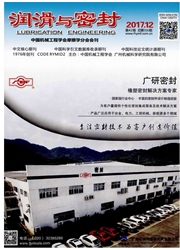

 中文摘要:
中文摘要:
利用光干涉技术观察球-盘运动状态由纯滑动变为零卷吸后接触区内润滑油膜的变化特征,得出不同于经典理论的结果,并将其归因于界面滑移效应。对于可能导致界面滑移产生的润滑油极限剪应力和界面临界剪应力2种机制进行分析,认为界面临界剪应力可以合理解释试验现象。为进一步证实分析的正确性,追踪零卷吸条件下冲击封油核心的运动规律,试验结果与分析结果相吻合。对零卷吸和球纯滑条件下封油核心运动速度进行定量对比,结果显示润滑油内存在同一不可超越的临界剪应力,得出镀有铬膜的玻璃盘界面具有较低的临界剪应力。
 英文摘要:
英文摘要:
Using an optical interferometry system, the elastohydrodynamic lubrication (EHL) films in a ball-on-disc contact were observed under pure sliding and zero entrainment velocity (ZEV) condition.The results are inconsistent with the prediction of traditional EHL theory, which is attributed to wall slippage effect.Two possibilities of wall slippage, i.e.the limiting shear stress of lubricants and the critical shear stress of interface were discussed. It is shown that the critical shear stress between solid-liquid interfaces may be responsible for the present observations.In order to validate the mechanism of critical shear stress, the movements of an entrapped lubricant in EHL contact were studied.The results show good agreement with the above assumption.By measuring the dimple core velocities under the conditions of ZEV and simple ball sliding,it is shown that the limiting shear stress of lubricant cannot be exceeded. Therefore, it is indicated that the glass interface coating Cr layer employs the lowest critical shear stress.
 同期刊论文项目
同期刊论文项目
 同项目期刊论文
同项目期刊论文
 期刊信息
期刊信息
